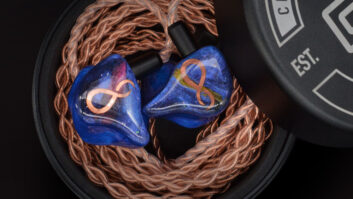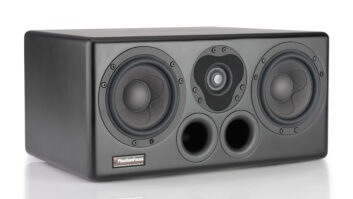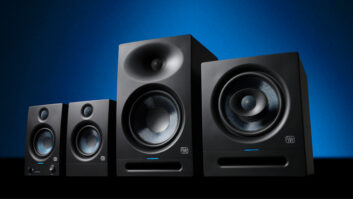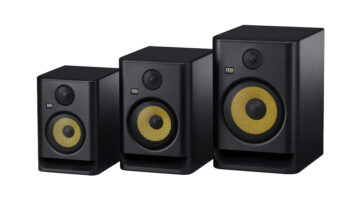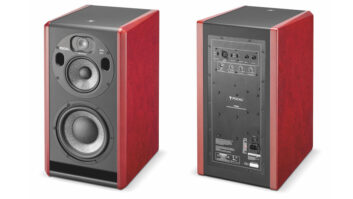Highly regarded as a manufacturer of precision microphones and mic preamps, Earthworks now turns its attention to the opposite end of the signal chain: introducing the Sigma 6.2 near-field passive reference monitors.
One look at the Sigma 6.2 and you know that this is no ordinary monitor. Viewed from the side, the cabinet’s profile resembles a staircase with unevenly spaced steps. The tweeter is inset in a vertical support perched on top of the lowest “step,” and the bass port vents out of the top portion of the speaker box instead of the lower section, eschewing the design of most other monitors.
Of course, the unusual design serves a purpose: Every aspect of the Sigma 6.2’s form has been fashioned to impart a completely transparent listening experience in the control room. A lofty goal, considering the laws of physics, but the Sigma 6.2 comes remarkably close to achieving it.
STAIRWAY TO HEAVEN
The Sigma 6.2 measures 16.75×9.5×15.5 (H×W×D) inches in its longest dimensions. The 1-inch-thick MDF (medium-density fiberboard) construction throughout accounts in part for the monitor’s hefty 32-pound weight.
The single 6.5-inch woofer and 37mm tweeter are both manufactured by Danish company Vifa. Details on the materials used in the construction of the tweeter and woofer were difficult to come by. The tweeter is made from some kind of fabric, and the woofer sports a “mineral-filled polycone.”
The Sigma 6.2’s tweeter is mounted in a vertically oriented slab of beveled 1-inch MDF and set back from the woofer in order to align the acoustical phase of the two drivers’ outputs. Unfortunately, the tweeter’s setback creates a physical shelf at its base (immediately above the woofer) that reflects acoustical energy emanating from the tweeter. To minimize the shelf’s depth (and thus any reflection-born artifacts), the Sigma 6.2’s woofer and bottom-front cabinet face are tilted so that the top edge of the woofer leans back toward the tweeter. (This arrangement also focuses the higher-frequency components of the woofer’s acoustical beam to align with the tweeter’s acoustical output.) Every cabinet edge for the monitor has a 1-inch radius to minimize diffractive effects.
The tweeter is driven by a 1-inch voice coil. A phase plug, located in the center of the tweeter (on the outside), reduces the crossover of acoustic energy from one side of the tweeter to the other. The tweeter is actually slightly inset in its beveled surround, forming a very shallow horn.
I also found it interesting that the tweeter is mounted slightly off-center (on a horizontal plane) in its MDF support structure and with respect to the woofer’s firing axis. Sigma 6.2s are sold as closely matched pairs, with one unit featuring a tweeter that is offset slightly to the left of the woofer’s center and the other unit sporting a tweeter offset slightly to the right. So, depending on which monitor you designate as the left and which as the right, the tweeters will be situated either slightly to the inside or outside with respect to the woofers’ centers. Earthworks specifies no “left” and “right” speaker assignments; users are left to their own preferences.
The tweeters are offset in order to de-emphasize the effects of “surface creep,” in which acoustical energy is re-radiated from the edges of a driver’s supporting structure. By offsetting the tweeters, frequencies that are re-radiated from the left and right edges of the tweeter’s support structure arrive at different times to the listener’s position, precluding reinforcement of undesirable artifacts. Pretty subtle stuff, but it’s exactly this attention to detail that makes the Sigma 6.2’s sound reproduction precise in so many ways.
The Sigma 6.2’s slot-shaped bass port fires out the top front face of the rear-most cabinet section. This unusual design maximizes the distance that acoustical energy radiating out of the back of the woofer must travel before leaving the port and combining with the woofer’s front-firing acoustical output. The longer this distance is, the lower the frequency will be at which destructive interference occurs due to phase interactions between woofer and port outputs (an unavoidable phenomenon). As you’ll soon see, this design has an audible impact on the Sigma 6.2’s spectral balance. The bass port’s inside edges are beveled to minimize acoustical resonances. By the way, the monitor’s port makes a great carrying handle, too!
Earthworks’ fastidious attention to detail carries over to the inside of the Sigma 6.2, with Solen polypropylene capacitors, OFC (oxygen-free) copper wire and WBT silver solder providing quality assurance.
CONNECTIONS AND PLACEMENT
The rear of the Sigma 6.2’s cabinet is fitted with beefy, gold-plated WBT binding posts and a Speakon connector with gold contacts, affording alternative methods to connect the monitor to a power amp. Earthworks asserts that the Sigma 6.2 presents a very easy load to a power amp, thus lessening the effect that suboptimal amplifier quality would have on the sound of the monitors. The company cites the Sigma 6.2’s power-handling specs to be 150 watts continuous program and 400 watts peak. Nominal impedance is 8 ohms.
The Sigma 6.2 is reasonably efficient, with a sensitivity rating of 87 dB (1 watt/1 meter). The monitor’s frequency response is specified to be “40 Hz to beyond 40 kHz, ±2 dB.” An included chart shows the frequency response to be down 6 dB at 30 Hz.
The supplied cut sheet (there is currently no owner’s manual) recommends placing the Sigma 6.2 three to six feet away from your listening position. You can put the monitors on a meter bridge without distorting a nearby CRT display’s image, as the Sigma 6.2 is magnetically shielded. Of course, you’ll get better results if the monitor is placed on a hefty stand.
A matched pair of Sigma 6.2s with standard black finish costs $3,500. Surround sound practitioners can buy a matched set of three monitors for $5,000. You can also be stylin’ with a pair of solid cherry-wood Sigma 6.2s for $5,000.
TO THE TEST
I connected a stereo pair of Sigma 6.2s to my Hafler P3000 Trans•nova power amp and placed the monitors in my Acoustic Sciences Corporation’s Attack Wall (a modular arrangement of cylindrical bass traps) in my control room.
Placed four feet away from my listening position, the Sigma 6.2s sounded extremely detailed, clear and revealing. Listening to some favorite reference mixes, I heard details that I’d never heard before. For example, background vocals that were tucked way back in the mix suddenly had more personality and nuance. Each instrument was more clearly defined, yet the monitors didn’t sound sizzly or hyped in any way. The bottom end was tightly focused and coherent, and I could readily tell the pitch of subterranean notes played on a Chapman Stick in a dense mix. Depth and stereo imaging were both excellent, and the reproduction of transients was absolutely phenomenal.
On the downside, I wish the Sigma 6.2’s bottom end sounded a little more prominent below 50 Hz, but that’s a lot to ask of two-way near-field monitors. The monitors’ upper-bass response also sounded a little lean, making the overall sound a bit thin. Performing some quick calculations, I estimated that the maximum amount of destructive interference between the Sigma 6.2’s woofer and bass port would occur at roughly 188 Hz. The supplied frequency-response chart shows a half-octave-wide, 2dB dip in response in precisely this band, corroborating both what I heard and later calculated.
This upper-bass dip, along with the Sigma 6.2’s superb coherency, no doubt contributes to the monitor’s decidedly open quality. When I moved my listening position to approximately 5.3 feet away, the Sigma 6.2s sounded a bit less open and detailed, but the perceived spectral balance improved in the bottom end. My personal preference, however, was to sit closer in where I could most readily hear the Sigma 6.2’s detail and clarity.
More so than with other monitors I’ve worked with, I much preferred listening to the Sigma 6.2s at low to moderate listening levels (below 85dB SPL). You can listen to the Sigmas at very low volume and still hear a surprising amount of high-frequency detail, which is a real benefit in long mix sessions. Also, the Sigma 6.2’s clean sound makes them very nonfatiguing.
CONCLUSIONS
If you’re looking for big-sounding monitors to revel in and impress your clients, the Sigma 6.2s will not be your cup of tea. The Sigma’s unhyped sound will probably be a little too unadorned for some folk. If, on the other hand, linearity and transparency are your main concerns, you’ll become positively addicted to the high-frequency detail, midrange clarity and tightly focused bass the Sigma 6.2s offer.
Complement them with a carefully chosen and tweaked subwoofer — hopefully one that offers adjustable gain and lowpass cut-off, as you really don’t need much low end to fill in the Sigma’s sound — and the Sigma 6.2s can serve as your main reference monitors. Alternatively, you can use them in the traditional role of near-fields to accurately assess all but your mixes’ low end, and refer to some big guns to ensure that you haven’t hyped the bass and kick too much.
The bottom line: The Sigma 6.2 is the tightest and most revealing near-field monitor I’ve had the pleasure to use.
Earthworks, 37 Wilton Rd., Milford, NH 03086; 603/654-6427; fax 603/654-6107; www.earthworksaudio.com.
Mix contributing editor Michael Cooper owns Michael Cooper Recording in beautiful Sisters, Ore.
